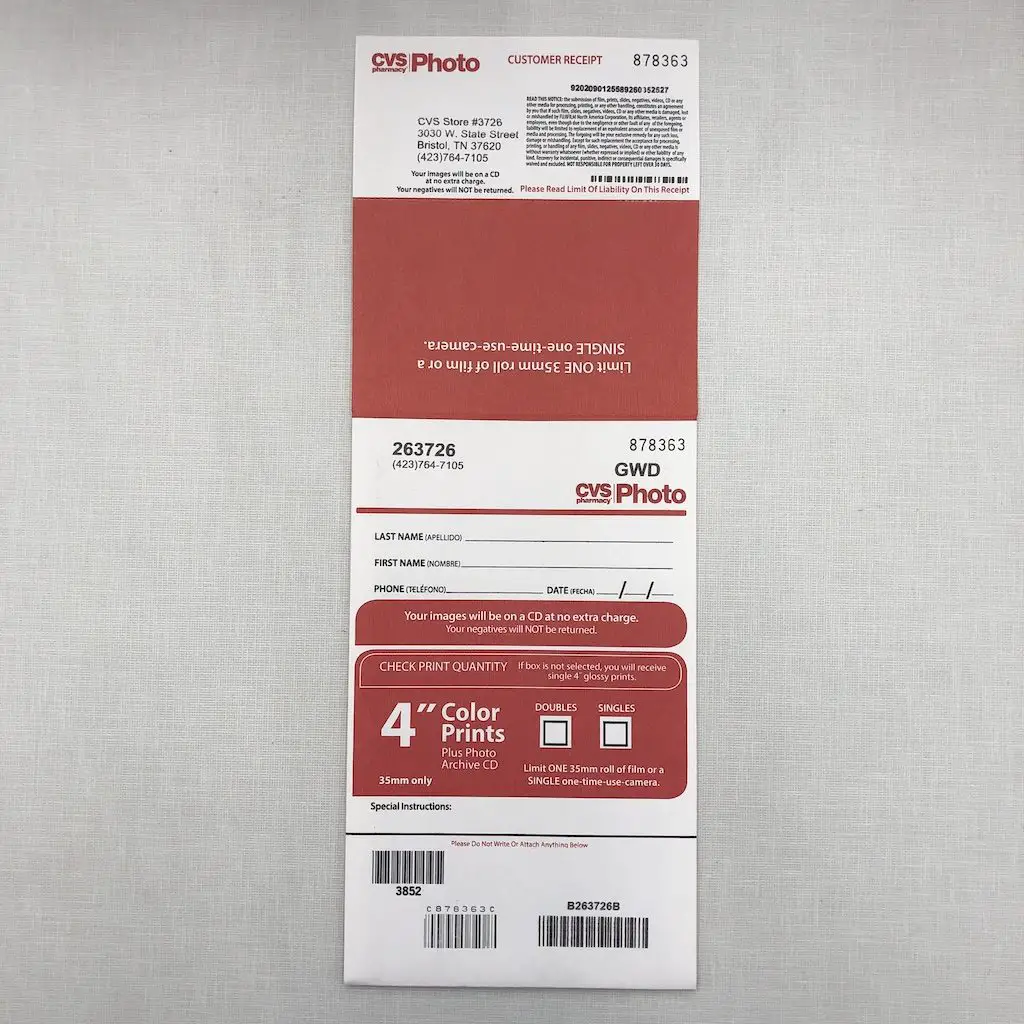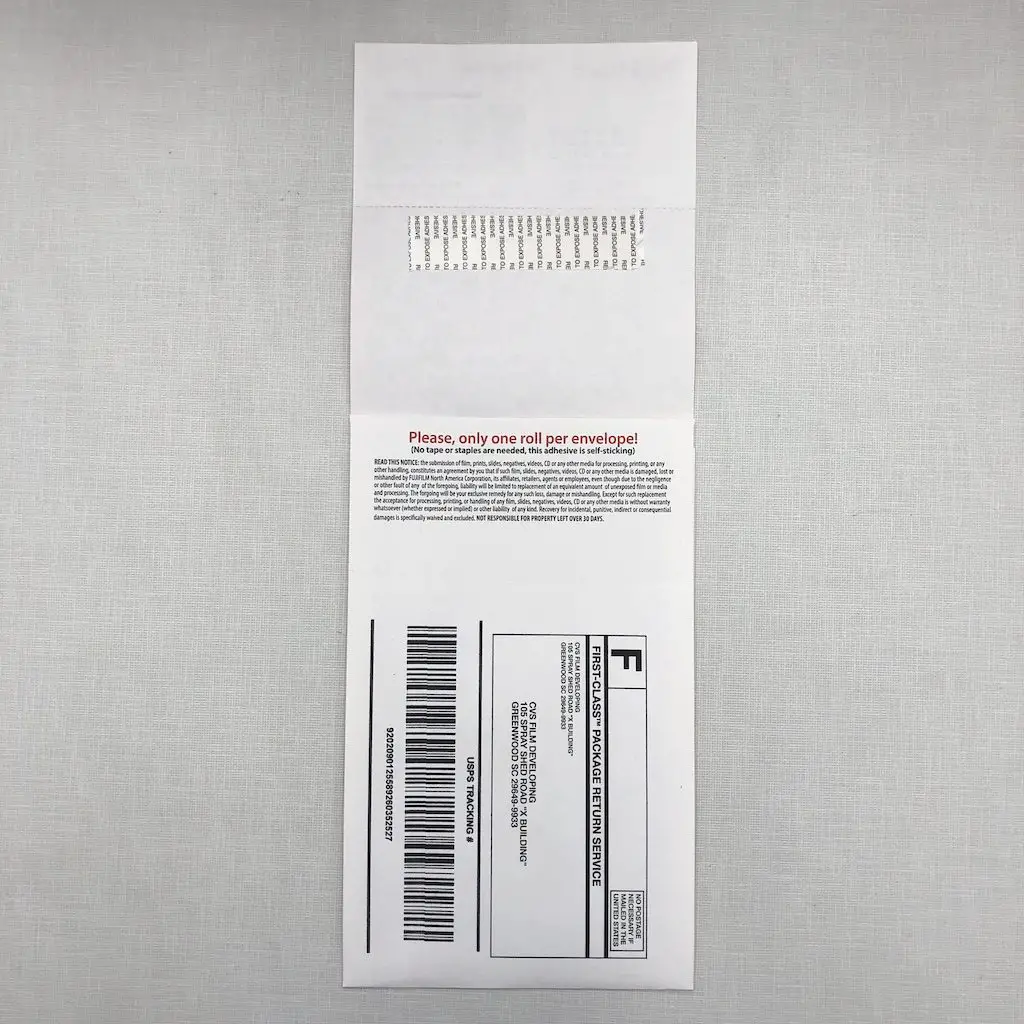CVS is one of the few places left available to most people in the United States that will still develop film, especially 110 film, but how much they charge to develop 110 film may be difficult to find.
CVS will develop 110 film and charges $14.42 (plux tax) to process either color or black & white 110 film. The price includes development, a set of 4 x 6 inch glossy prints, and a free CD of your digitally scanned negatives. However, CVS won’t return the film negatives back to you.
Now that you know how much it costs to develop 110 film at CVS. Keep reading to see how much it costs for a double set of prints, how long the process takes, and how to get the images onto your phone.
How Much Does It Cost to Develop 110 Film at CVS?
CVS is the in the middle of price of retail / pharmacy stores for developing either color or black & white 110 film between Walgreens (the most expensive for 110 film)  and Walmart (the cheapest for 110 film
and Walmart (the cheapest for 110 film ). CVS charges to develop film by going by the number of exposures a roll of film can hold and since the most common amount of exposures for 110 is 24 frames, it costs $14.42 for 1 set of glossy 4×6 inch prints and $17.85 for 2 sets of glossy 4×6 inch prints. A free CD of your digitally scanned negatives is also include with either.
). CVS charges to develop film by going by the number of exposures a roll of film can hold and since the most common amount of exposures for 110 is 24 frames, it costs $14.42 for 1 set of glossy 4×6 inch prints and $17.85 for 2 sets of glossy 4×6 inch prints. A free CD of your digitally scanned negatives is also include with either.
# of Disposable Camera Exposures | Single Set of Glossy Prints (4×6 in.) | Double Set of Glossy Prints (4×6 in.) |
|---|---|---|
24 | $14.42 | $17.85 |
27 | $14.99 | $18.99 |
36 | $16.99 | $21.99 |
Since CVS doesn’t return your negatives and the scans are not high-quality, see this list of places to get 110 film developed about the same price with better quality scans and your negatives returned. Also see this guide about how to ship your film safely and inexpensively
about the same price with better quality scans and your negatives returned. Also see this guide about how to ship your film safely and inexpensively to one of these online labs.
to one of these online labs.
How Long Does It Take to Develop a Disposable Camera at CVS?
Depending on where you live it could take up to 3 weeks or more to develop your roll(s) of color or black & white 110 film. This is because CVS (similarly to Walgreens and Walmart ) doesn’t develop film onsite and sends it all to a third party developer, such as Fujifilm North America.
) doesn’t develop film onsite and sends it all to a third party developer, such as Fujifilm North America.
However, 35m color film or a disposable camera with color film takes the shortest amount of time at around 7 – 10 days or more. If you develop another format like 35mm black & white film, a disposable camera loaded with black & white film, APS (Advantix),or slide film (E-6) the processing time will be long at up to 3 weeks or more.
Update for 2022: Since 2021 I have found that because of the pandemic drug stores like Walgreens, Walmart, and CVS have a much longer turnaround time then previously reported. For example, I am still waiting for some color 35mm film to be developed from my local CVS for 4 months when it should have been only 2 – 3 weeks. For this reason I highly suggest that you don’t use a local drugstore and use an online film development lab to develop film with a shorter turnaround time instead.
to develop film with a shorter turnaround time instead.
How Do You Develop 110 Film at CVS?


The process to have a 110 film developed at CVS is very easy (and a very similar process to Walgreens and Walmart ). All you you need to do is to fill out information on their own paper envelope and put your disposable camera (one camera per envelope) into it. The steps are as follows:
). All you you need to do is to fill out information on their own paper envelope and put your disposable camera (one camera per envelope) into it. The steps are as follows:
- Locate and go to a CVS
 physical location with a photo department. Bring along your undeveloped disposable camera and ask for a film development envelope.
physical location with a photo department. Bring along your undeveloped disposable camera and ask for a film development envelope. - Fill out the envelope with your information and the list the amount of prints you want.
- Place your exposed film inside the envelope and seal it. Note only film roll per envelope so if you are developing multiple film rolls, you will need multiple envelopes with your information and number of prints.
- Drop the completed enveloped with your information and number of prints into the collection box in the photo department of the CVS.
CVS will notify you by phone once your order has been processed and ready to be picked up and you’ll pay with you pick up your CD and prints. With your order you will receive is a CD with your digitally scanned negatives on it for future printing or sharing on social media and 4×6″ glossy prints. If you ordered more prints you will also receive those.
How Do I Get Images from My 110 Film to My Phone?
There are two basic approaches to getting images from your 110 film to your phone. Once you finish taking all the images on your 110 film, you will first need to develop your film by using an online (or local) film development lab or a local drugstore.
Using An Online Lab To Get Images from 110 Film
If you choose an online lab to develop your 110 film they will send you your scans back and you can download them to your phone or you can scan the negatives yourself using a scanner, dedicated camera set up, or a smart app.
they will send you your scans back and you can download them to your phone or you can scan the negatives yourself using a scanner, dedicated camera set up, or a smart app.
Using CVS To Get Images from 110 Film
However, if you choose to develop your 110 film at a local drug store like CVS, you will receive a set of glossy 4×6″ prints (one for each of your exposures) and scans of your negatives on a CD with your purchase. Since most computers available now don’t have a CD-rom drive to access the images on the CD that you get back from CVS, I recommend bringing along a USB flash drive to make it easier to transfer the images from the CD to the USB drive at one of the photo kiosks located in CVS. Then you can transfer the images from the USB to your computer and then to your mobile device.
Using An Smartphone App To Get Images from 110 Film
Another option is using a smartphone app like PhotoScan by Google to scan the 4×6 prints you receive back from CVS. The free app is available for iPhone phones
to scan the 4×6 prints you receive back from CVS. The free app is available for iPhone phones and Android phones
and Android phones and takes high resolution images of prints without reflections as well as automatically crops, resizes, rotates, and enhances the image.
and takes high resolution images of prints without reflections as well as automatically crops, resizes, rotates, and enhances the image.
Pros & Cons of Getting A 110 Film at CVS
CVS is a good place to develop your 110 film because of its convenient locations, decent quality photo prints, and has better scans than Walmart. Similar to Walgreens
because of its convenient locations, decent quality photo prints, and has better scans than Walmart. Similar to Walgreens and Walmart
and Walmart , CVS doesn’t return your negatives. If you want your negatives returned and/or you care about getting more than low quality and low resolution scans, I suggest that you read this guide that lists several places to get film developed
, CVS doesn’t return your negatives. If you want your negatives returned and/or you care about getting more than low quality and low resolution scans, I suggest that you read this guide that lists several places to get film developed that will return negatives and give you much better quality scans.
that will return negatives and give you much better quality scans.
Below are a list of pros and cons about getting a 110 film developed at CVS.
Pros:
- Many locations available so it is likely near you

- No shipping cost
- Can develop both color and black & white 35mm film including disposable or single-use film cameras
- Free CD of scanned negatives and a set of glossy 4×6 inch prints included with development cost
- Will call you when your order is ready
- Decent quality scans but low-resolution (compared to Walmart
 )
) - Good option if you are using expired film and not sure how the negatives will turn out since it is so inexpensive (but don’t get film negatives back)
Cons:
- Long wait time of 3 weeks or more for 110 film
- Get back low-resolution scans and prints
- Get back low quality scans
- Don’t get your negatives back
- Prints are not as good as Walgreens
- Very little, if any, customer service – drop film in a paper envelope in the store
- No online film development ordering available (must go to location)
- Slightly more expensive than Walmart
- No bulk pricing available
- Price for development cost lands between Walgreens and Walmart. With Walmart being the least expensive and Walgreens being the most expensive
You can find more details and comparisons developing your film at Walmart, CVS, or Walgreens by visiting this guide .
.
